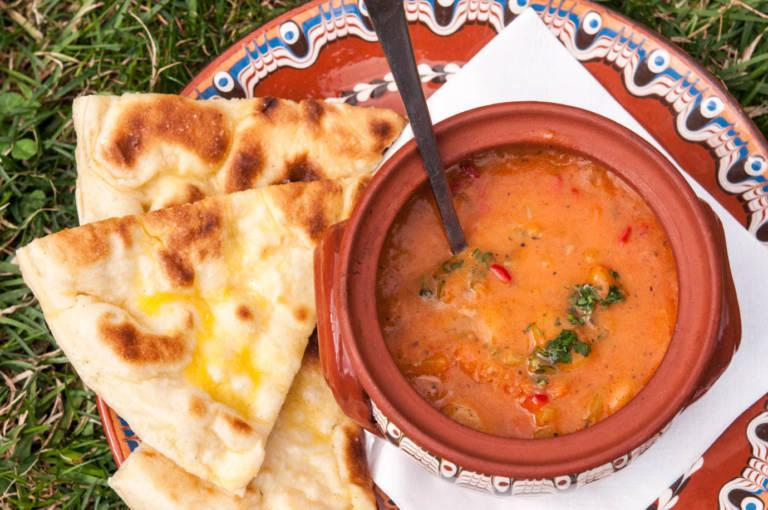Rhodopes cuisine depended on the climate and the landscape back at the days. As the
mountains were difficult to hike every day and there were no roads, locals relied only on their
own production. Beans, potatoes, and wheat are grown in the region. Milk and dairy products
are always present in the Rhodopes’ menu. Salted and dried meat is easily stored in the
winter. The housewives had to diversify every day’s menu and that’s how combinations like
potatoes with white beans, cabbage with rice, beans with lentils and potatoes were created.
Typical meze on the table were “sazdarma” (homemade boiled meat) and “pastirma”
(homemade dried meat). For dessert, something called “kiln” (phyllo pastry) filled with rice,
pumpkin, bulgur and other ingredients is served. For digestif, locals drink “luto” – fruit drink
prepared of rosehips, blueberries, apples, pears or dried fruits. A cup of “Mursal tea” made of
mountain herbs that warm your heart in the evening is also a good idea.
Let’s embark on this culinary adventure . . .
First thing in the morning – breakfast!!! Breakfast in the Rhodopes is abundant. Wherever
you go, you will be offered “mekitzi” (big fried donuts) for breakfast. They are made of
fluffy white dough and fried in sunflower oil. Don’t worry if you are on a diet – they will
give you enough energy to go for a long hike in the mountains and the region. Mekitzi go
together with a cup of Mursal tea.
Lunch can be lighter and vegetarian
Let’s start with a soup made of corn tarhana with meat. “Tarhana” is a dried food ingredient
based on a fermented mixture of corn grain. It’s a basic soup with corn tarhana, lamb, butter
and dried paprika.
Kačamak – this is a maize porridge typical for the Balkans. You can add butter, milk,
pumpkin, walnuts, rice and other ingredients.
Patatnik – the most famous Rhodopes dish. It’s a kind of potato pizza with typical Bulgarian
products like white cheese and butter. Very delicious and nutritious.
Turp (beetroot) with white beans – this is a heavy dish characteristic of the Rhodopes. It’s
prepared with white beans and beetroot. As there is no abundance of vegetables in the
mountains, locals have to be creative and use the products they do have.
Porridge – Rhodopes porridge is usually made of semolina and vegetables. You can also add
meat, butter or anything you like. Locals make the semolina themselves and prepare a bigger
quantity of it at one go to have enough for the whole season.
Cheverme – this is a feast dish. It’s a lamb barbecue and the animal is cooked outside the
house in an open space for a special occasion – baptism, wedding or a local celebration.
When there is a Lamb Barbecue, no other dishes are cooked. After the meat, comes the
dessert called “kiln”
Klin – this is the typical Rhodopes dessert. It’s prepared with phyllo pastry filled with
spinach, pumpkin, rice or bulgur. Locals also add sugar to make it sweet enough.
Marudnik – or in other words Rhodopes pancakes. They are made of wheat, but without any
liquids added – no milk, no water. The main ingredients are yoghurt, eggs, wheat and baking
powder. Don’t miss out to try these pancakes, they are heavenly delicious!!!
Luto – after the meal comes the digestif. It’s a cold drink prepared of rosehips, apples, wild
pears or dried fruits. The best “luto” however is made of blueberries. To preserve the drink
for several months, cherry leaves are placed in the bottles. Pelargonium roseum or basil
leaves are also outstanding preservatives.
Rhodopes meze – due to the climate, locals had to find a way to preserve meat longer and
that why they traditionally prepare salted and dried meats. People eat lamb and beef in the
Rhodopes. One of the specialties of the region is called “dried meat” which is made of beef
and sea salt. The meet is well salted, left to dry and washed in salted water afterward.
Another local specialty is called “sazdarma”. It’s prepared with lamb together with its fat.
The lamb is cut in pieces, well-salted and left apart for a while. The fat is boiled and cleaned
up. Both are put together is a casserole and cooked together. When cooked this way, the meat
can be preserved for 6 months.
Mursal tea (Sideritis Scardica) – it’s a herbal, mountain tea that has different names in
different regions in Bulgaria – Mursal tea, Trigrad tea, Alibotush. Its aroma and taste warm
the body and the soul after a long day spent in the mountains.
This culinary adventure comes to its end and it’s time to say “Good buy”.
If you are interested to live the “Rhodopes fairy tale”, check out our website and embark on
one of our tours. See you there!

Author and Photographer: Julia Dimova
Pictures of our “Rhodopes Fairytale” tour

